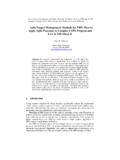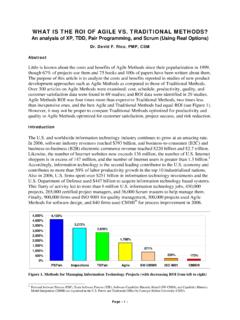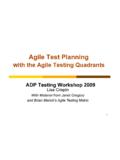Transcription of Quality Assurance in an Agile Environment - SPIN
1 Quality Assurance in an Agile Environment1 Discussion Topic The Agile Movement Transition of QA practice and methods to Agile from Traditional Scrum and QA Recap Open is Agile ? of Agile Agile software development is a group of software development methodologies that are based on similar principles. Agile methodologies generally promote a project management process that encourages frequent inspection and adaptation, a leadership philosophy that encourages teamwork, self-organization and accountability, a set of engineering best practices that allow for rapid delivery of high- Quality software, and a business approach that aligns development with customer needs and company goals Agile Does NOT stand for Anything Goes Methodology Agile is a lean method of software product development that is highly dependent on team interaction and rapid feedbackCharacteristics of an Agile Team Execute Project deliverable in small increments with minimal planning, rather than long-term planning Development & QA is done short time frames (known as Sprints')
2 Which typically last from one to four weeks Each iteration is worked on by a team through a full software development cycle, including planning, requirements analysis, design, coding, unit testing, and acceptance testing when a working product is demonstrated to stakeholders Agile methodologies include a routine and formal daily face-to-face communication among team Agile is, while there is value in the items on the right, we value the items on the left moreMisconception that items on the right are not important! It s the relative value being The Software Development Evolution Traditional to Agile Growing Realization that Requirements are never fully understood Fast paced development environments using new development Technologies and Tools Move towards business models like SaaSand software architecture like SOA Shortened product delivery cycles Increased involvement of business users in the development cycle Migration towards Agile product development models like SCRUM, RUP.
3 Framework using a Holistic in Traditional Environment The Pros and Cons PROS Elaborate documentation available for preparing test cases Ample time for test planning Stable requirements means less re-work on test cases CONS Any major requirement change/addition throws the QA schedule out-of-gear Any uneven distribution of effort between QA Planning and Execution phases cannot be realized earlier QA has to absorb the delays introduced by the BA/Development teams leading to compressed QA execution time and inadequate s Struggle with Creep Requirement changes and updates are inherent to Agile methodology and QA s biggest challengeInadequate time to prepare test plansMinimal requirements documentation to prepare the test casesHighly compressed test execution cyclesMinimal time for regressionChange of role from being a Gatekeeper of Quality to being a Partner in QualityOften required to play a semi-developer roleManaging Quality in Agile ModelWhat moving to Agile does notmean for Sprint feature specific testing only with less emphasis on System Integration testing Minimal Test documentation Ad-hoc Testing with `best possible coverage Being just an extension of development team Losing the user perspective of the product Freedom from ownership of Quality of the product!
4 Quality in Agile ModelWhat moving to Agile doesmean for Participate ownership on Quality A team of equals. Quality is Team s responsibility. Role of QA is around defending the Quality for the team by developing proper measures User or Product representative involved in all phases guiding Quality Agile team Quality analyst is adaptive rather than predictive Scrum -An Agile MethodologyGenesis of Unified Scrum Approach Using Unified Business case and Approval Product Roadmap Initial product backlog Initial release plan Architectural DirectionFeature backlogImpediment listProduct backlogSprint backlog burndownsprint backlogProduct burndownArtifacts Sprint Planning meeting Update product backlog Sprint retrospective Backlog review Release Daily scrumInceptionRelease CyclesProduct ManagerUsersStakeholdersTeam membersScrum masterScrum rolesPractical Implementation: Unified Scrum Approach to Application Development & QA During of Roles in Unified Scrum Horizontal tracks define different roles in Unified Scrum team BUT Roles can be interchangeable for a given resource One resource does NOT have to tie themselves to One Role Crossover of roles is encouragedfor example, a BA in one sprint may be a QA in the next or sometimes, in the same sprint Developers can perform BA roles often times during peak analysis times at the inception of the project QAs often play the role in UAT and deployment and rollout.
5 Key is to adaptto what best suits your organizational culture and QA in Unified Scrum Test planning and Test Case development Test Data requirements definition Test Scripts documentation in collaboration with BAs and Developers Test cases reviewed by BAs Regression tests conducted on prior featuresTypical QA in Unified Scrum 2 Additional test cases written Reviews from BAs incorporated Initial Builds are reviewed and defects reported Regression tests conducted on prior features Sprint test execution begins in full force at the end of Week 2 Typical QA in Unified Scrum 3 Sprint test execution conducted in full force Defects reported and daily defect review meeting conducted Fixes Retested End of Week Quality Signoff Release Release notes identifies open defects and approved features Sprint RetrospectiveQA in a typical SCRUM the emphasis on test documentation can lead to half-baked casesTest coverage is dictated by time availableRequirement changes -if not communicated effectively results in QA executing invalid test cases or rendering test cases already executed uselessOften System Integration test cases get left out with focus only on the features delivered for the sprint Low emphasis on documented status reporting and management reporting makes it difficult to track overall state of the Quality of the productSample QA Process Flow in Unified Scrum in Agile QA Lean S/W DevelopmentEliminating Waste in the System!
6 Don t produce code that is not testable. Think QA before writing the code! QA is NOT a separate team with separate function at the end of the assembly line QA activities and people should be involved in the development of the product duringthe development Minimize Handoffs -avoid the traditional User-BA-Arch-Dev-QA model Write test first and use all the frameworks that will facilitate your test suite Automate testing, building, installations, anything that is routine, but do it smartly (read flexible) Re-factor code to be more streamlined, simpler the code-more effective it will be in production and to maintain Most importantly build Quality in the -QA Mindset in an Agile Methodology Quality is responsibility of the ENTIRE Scrum Team Quality Gate does NOT only mean System Testing but the entire application Continuous Integration will Lead to Continuous QA Progressive inclusion of System Integration test cases from sprint to sprint QA resource plays a role of BA/QA removing any gaps in requirements communication Prioritize Test Cases by Risk and Frequency of Feature Usage Utilize the Sprint Retrospective to Identify Where in the scrum process did failure of Quality occur (Root Cause Analysis)







